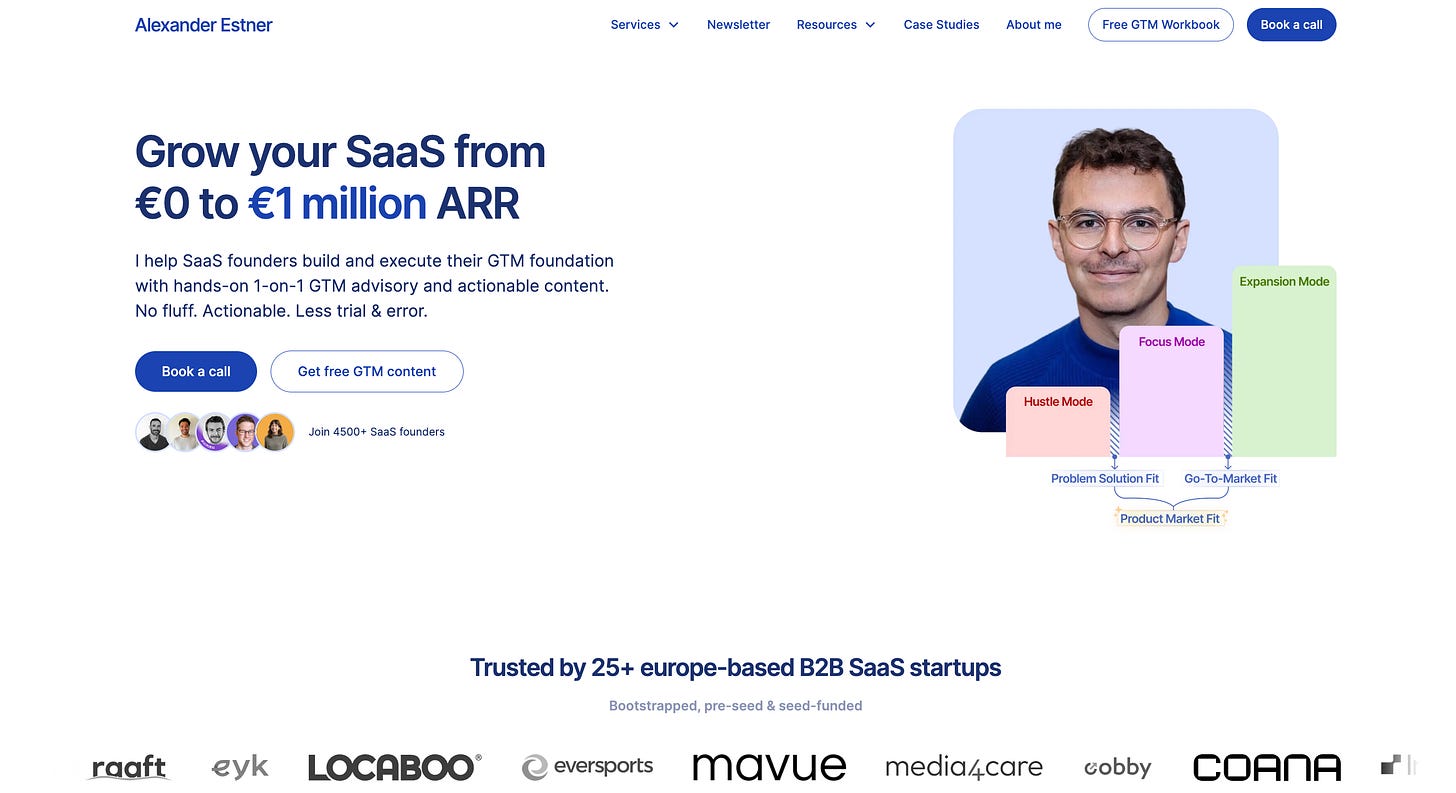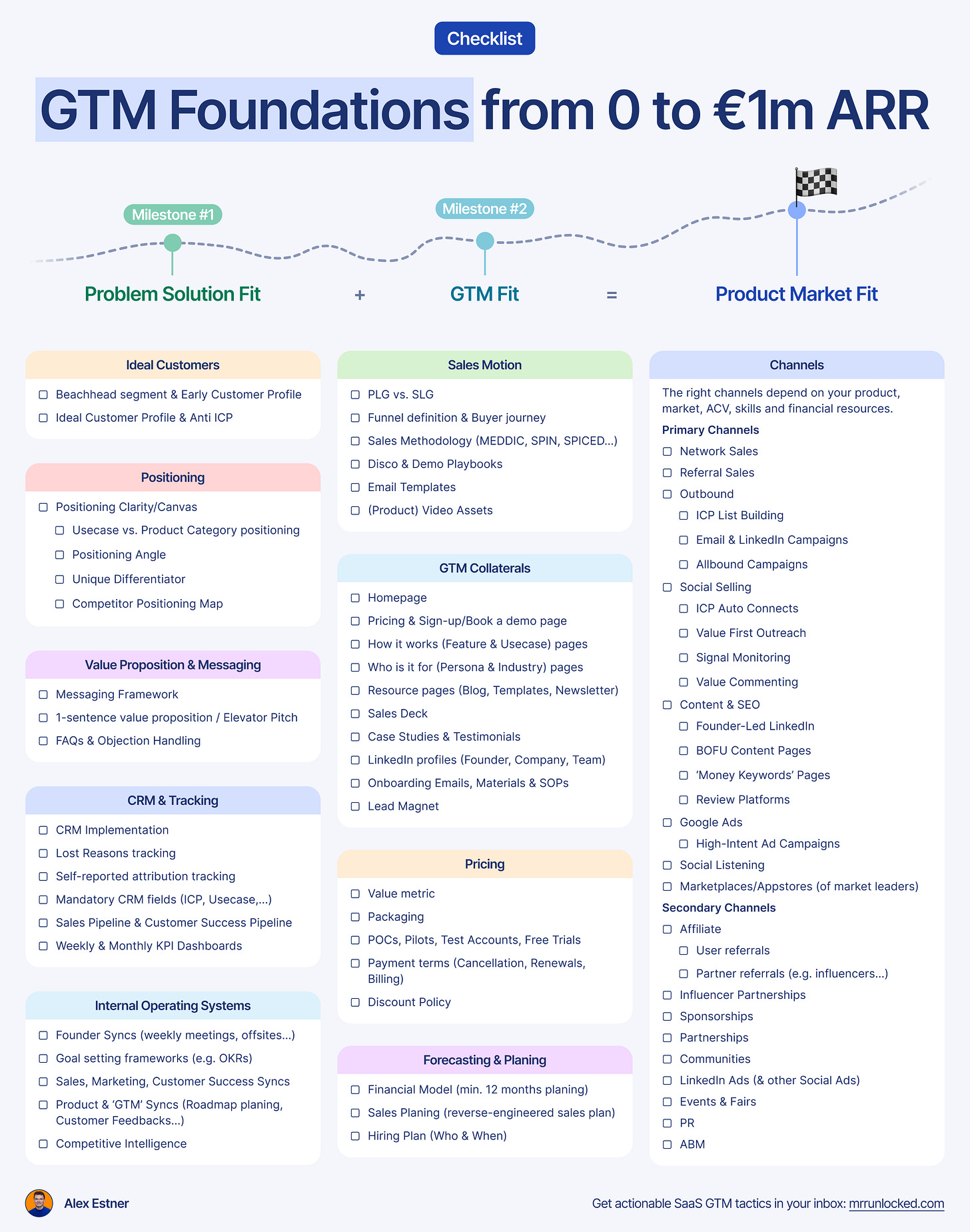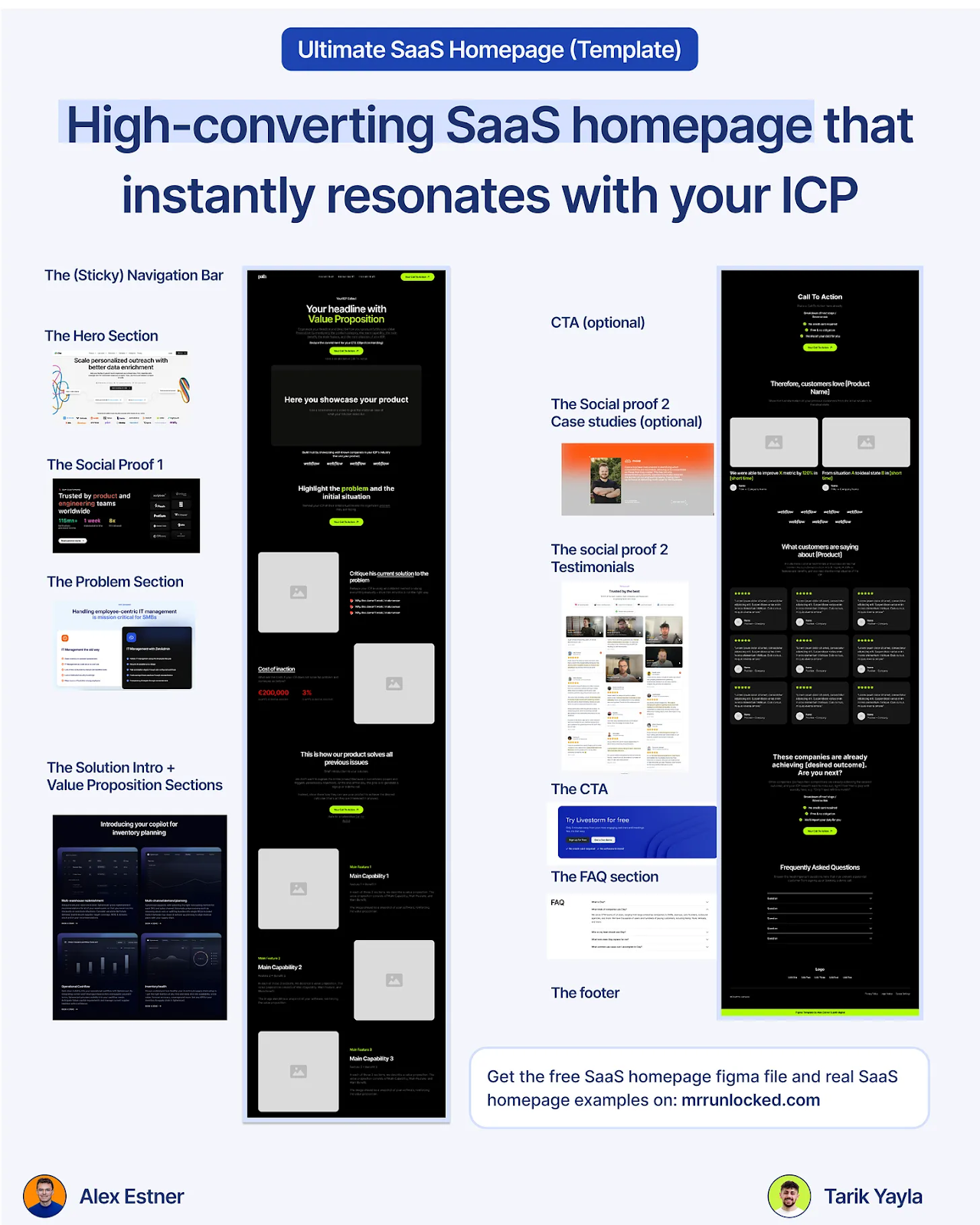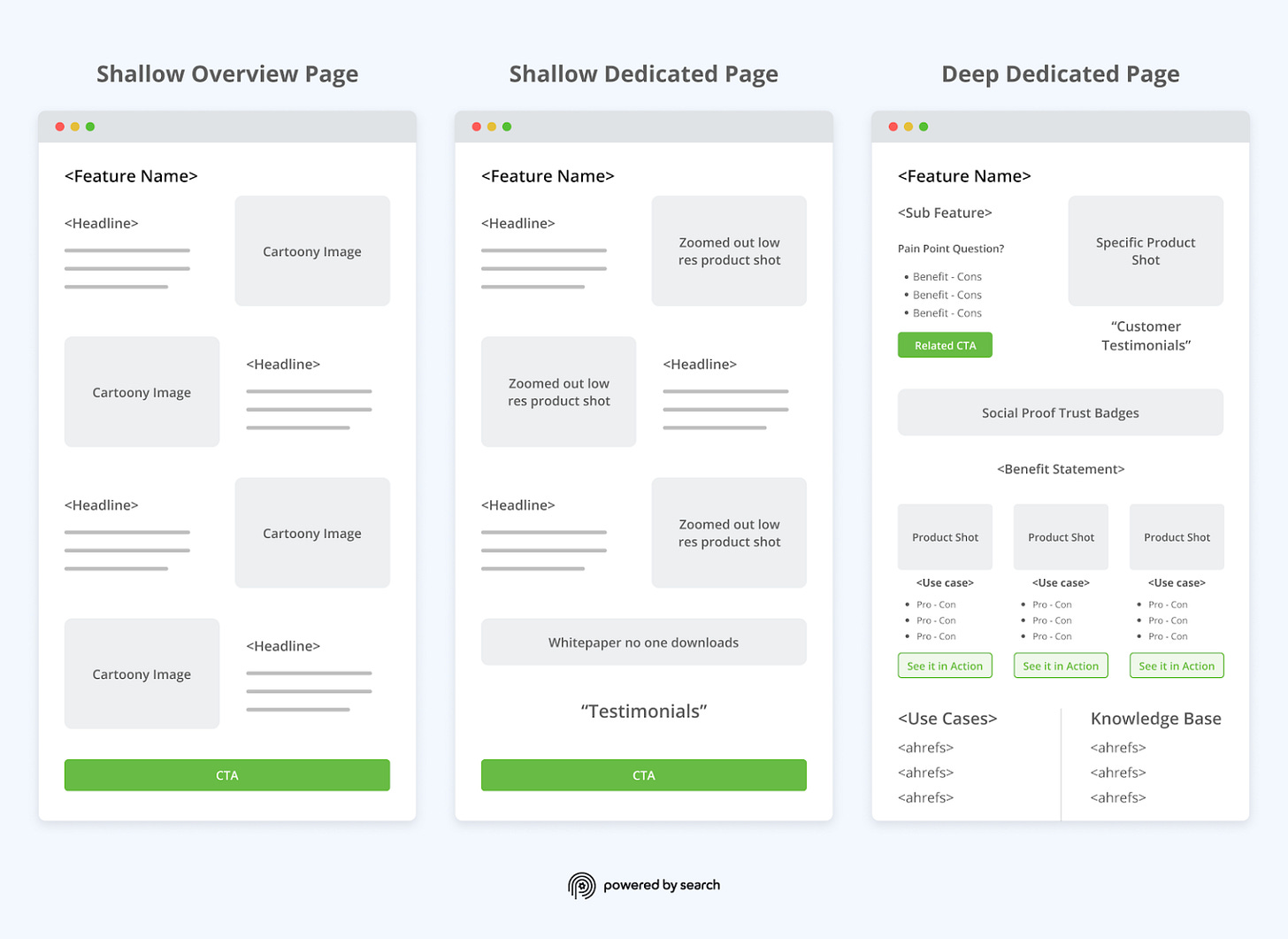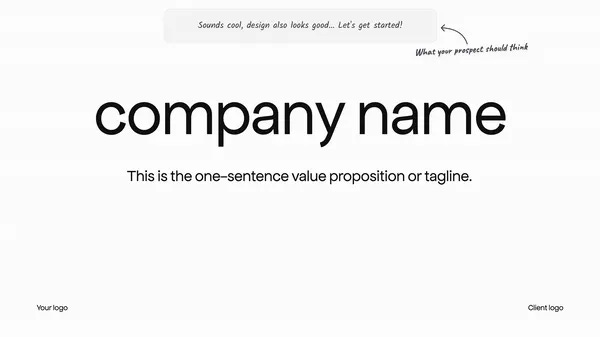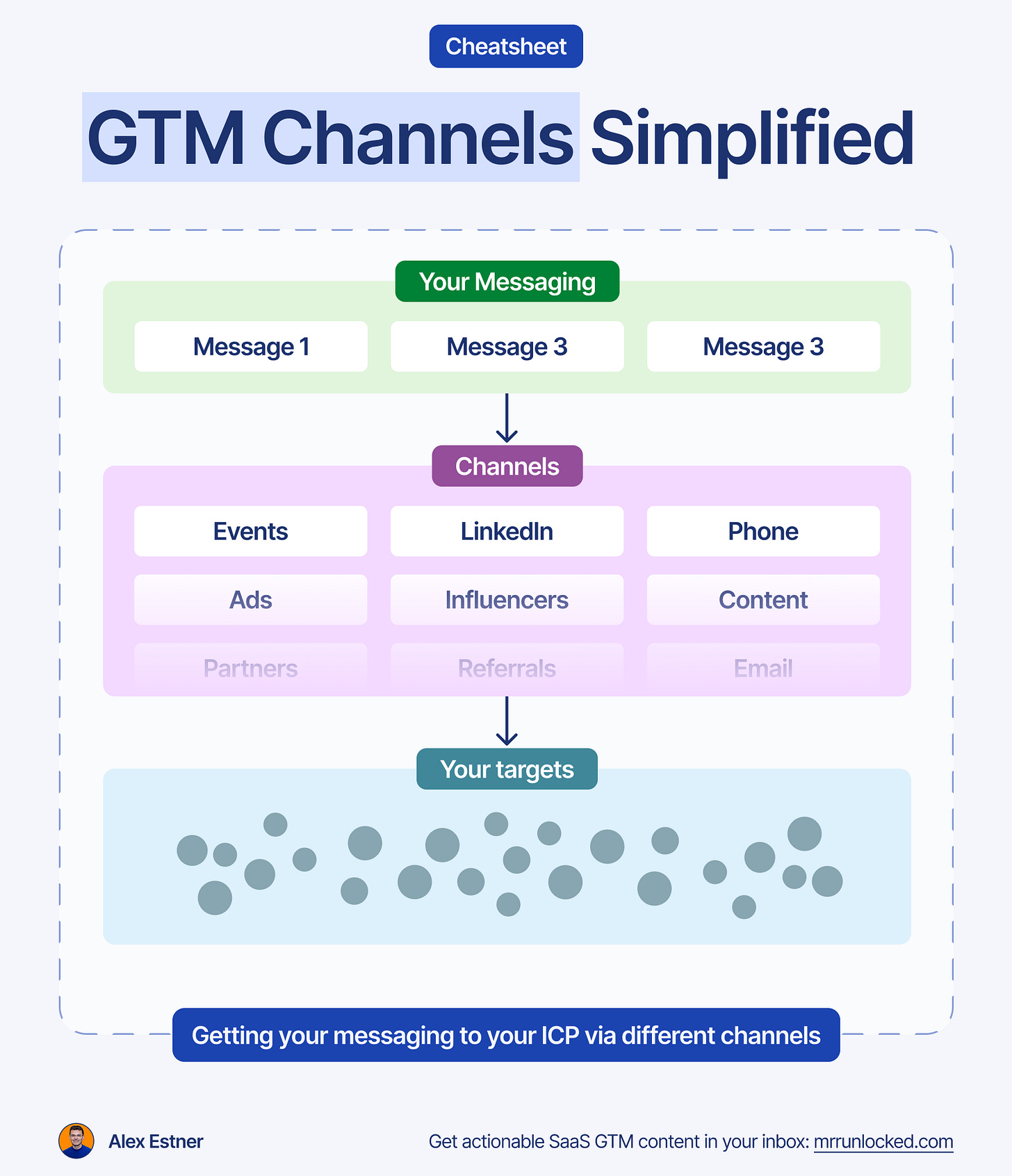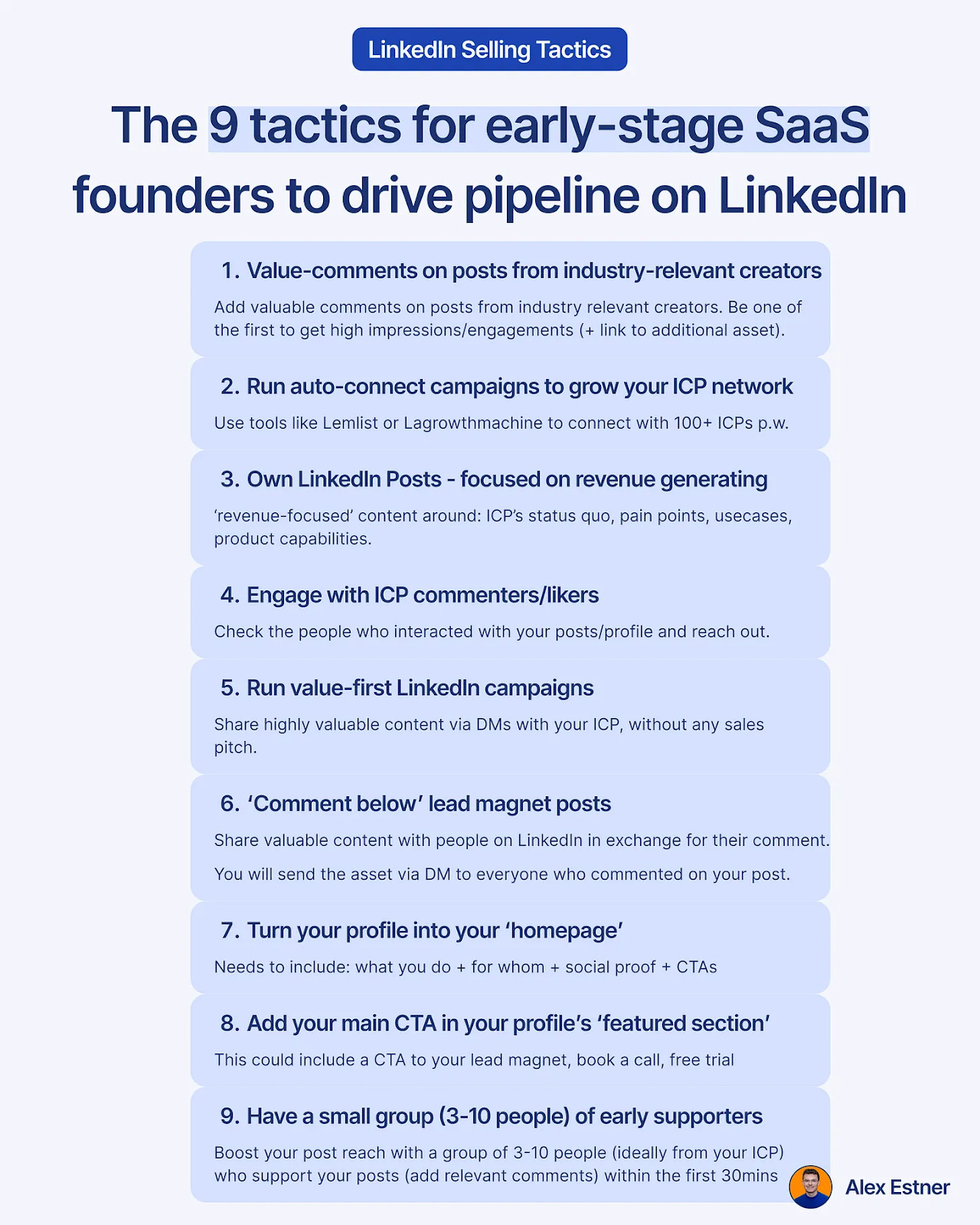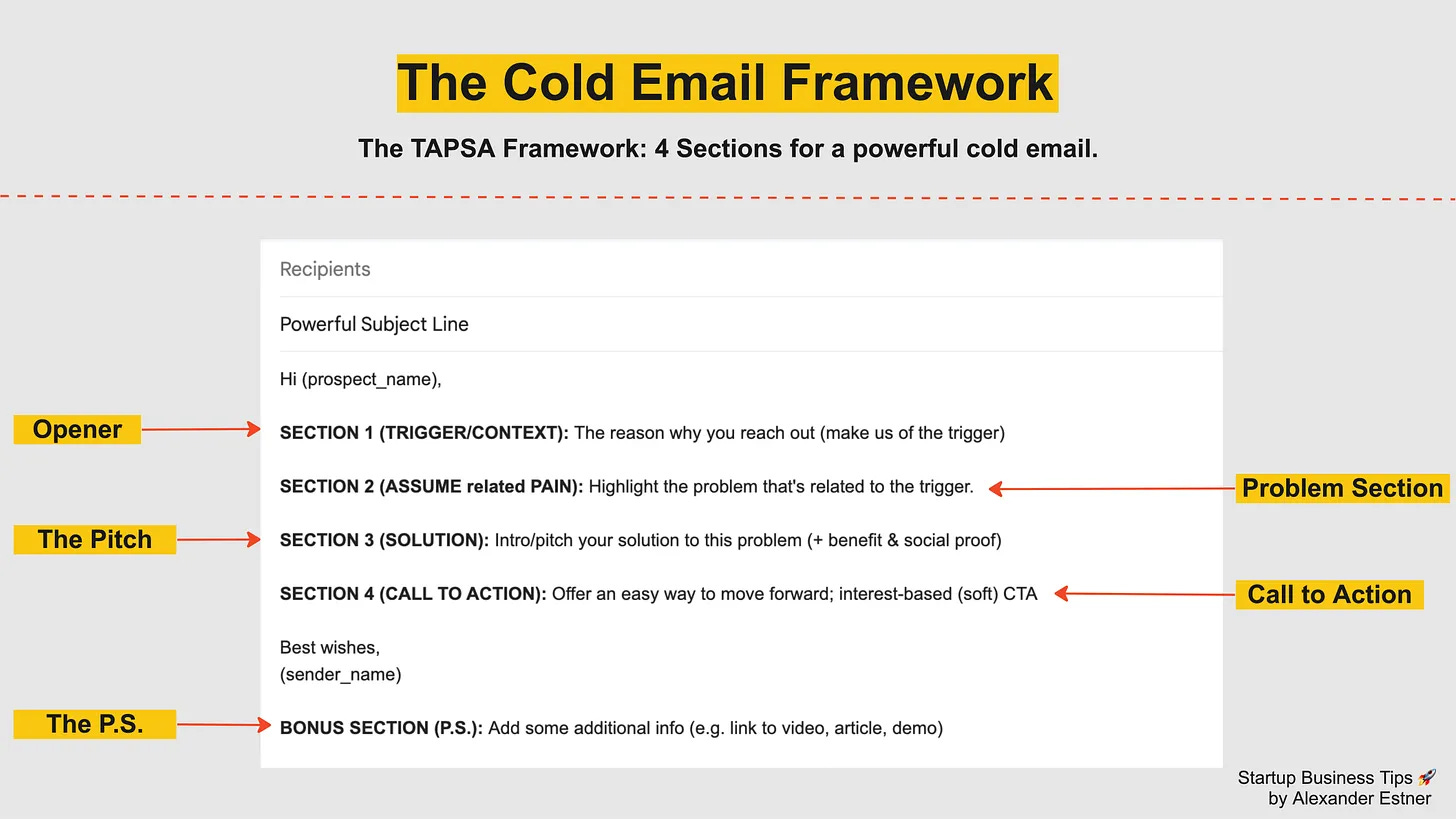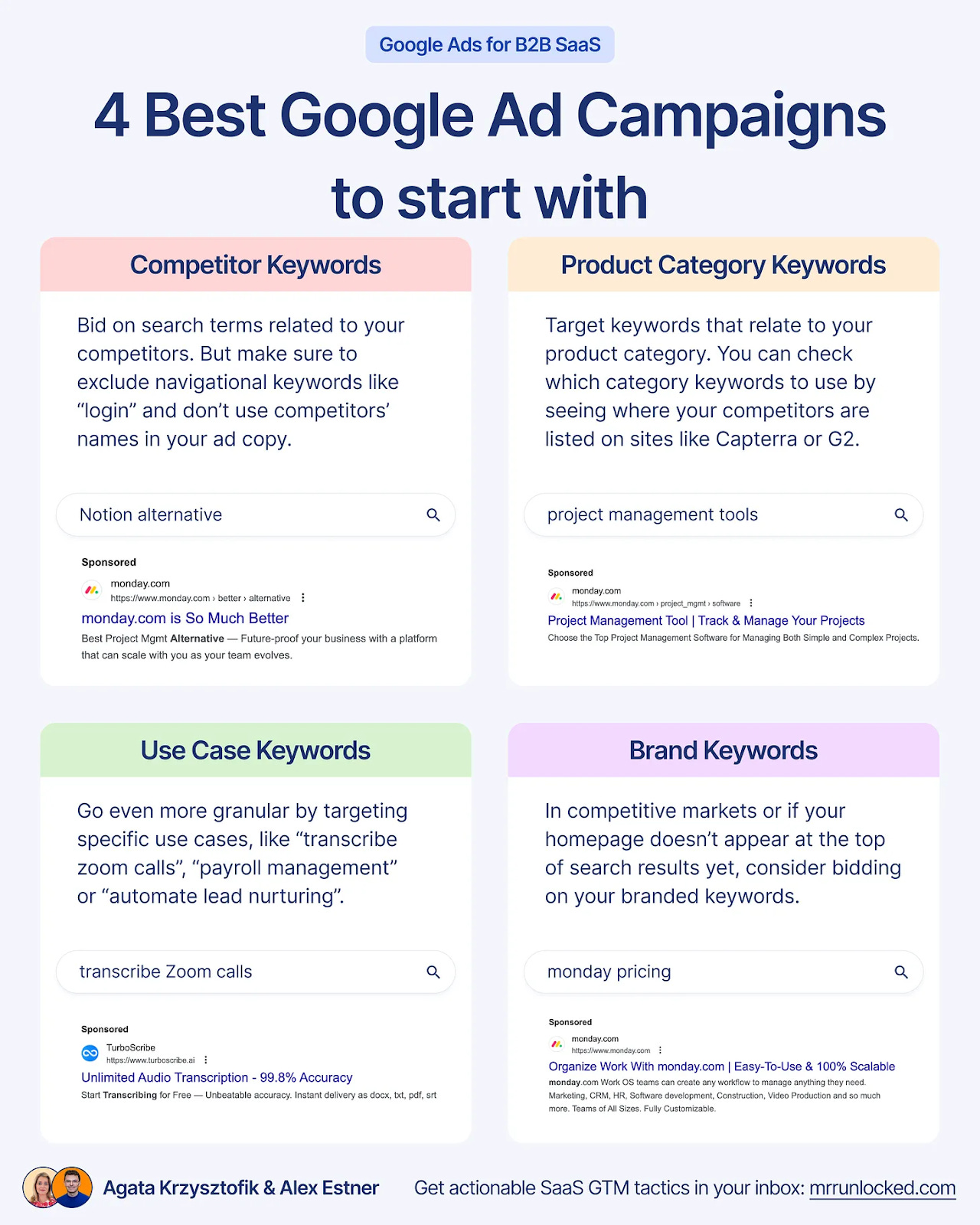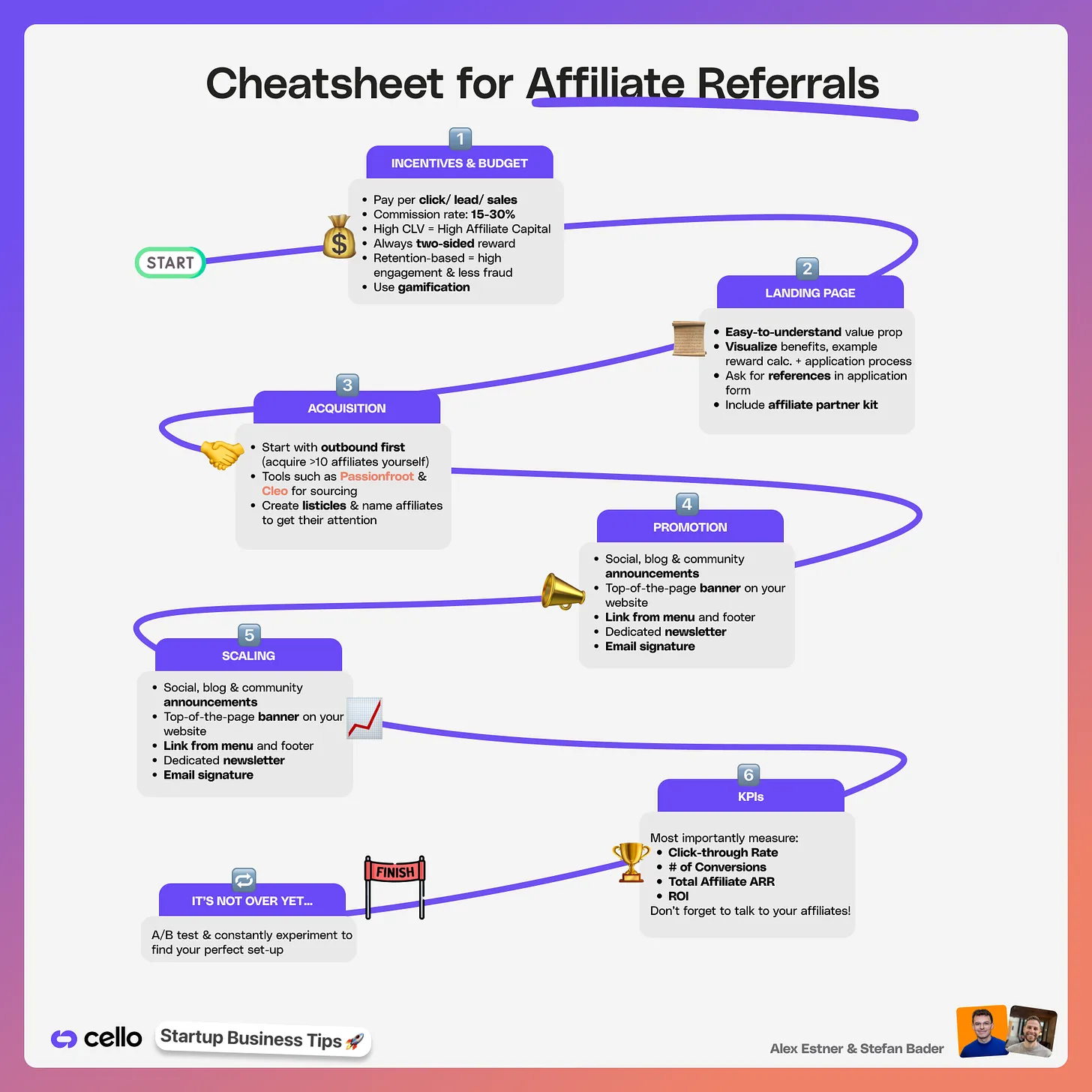GTM Foundation: How SaaS Founders grow from €0 to €1M ARR (Part 2)
GTM Assets & primary and secondary GTM Channels
Hey - it’s Alex!
Today we cover:
1️⃣ How to turn your GTM strategy insights into strong GTM collaterals
2️⃣ The right primary and secondary GTM channel for your SaaS (21 GTM channels)
Bonus: Build and execute your GTM foundation in 6 months with my 1-on-1 GTM advisory
Note: This episode might be too long for your email client. Read the full guide on web.
This is the 2nd part of my GTM Foundation series. Don’t forget to catch up on part 1 — building the GTM strategy pieces - ICP, positioning, and messaging and part 3.In case you missed the last 3 episodes:
✅ GTM Foundation: How SaaS Founders grow from €0 to €1M ARR (Part 1)
✅ The 10 most common GTM myths
Personal update: I just launched my new website 🎉
Roast it, review it, or rip it apart - whatever helps me improve.
Just hit reply with your honest thoughts.
P.S. In exchange, I’ll happily roast your website too 😀
The SaaS GTM Foundation to grow to €1 million ARR and beyond
As you might know, building the GTM foundation from €0 to 1€ million ARR is very special to me. 🙌
It’s what I’ve been doing the past 3+ years.
So, before we jump right into it, I want you to be with me, so we have the same understanding.
I want you to understand the following 3 things:
Make sure you read part 1 of the GTM Foundation
GTM foundation = What brings you to Product-Market Fit & 1€ million ARR
The 0-1€ stage is at least 3 different stages:
👉 Hustle mode,
👉 Focus Mode, and
👉 then Expansion Mode.
You need to reach problem-solution fit, then GTM-fit, BEFORE you scale.
GTM Foundation consists of (at least) 10 fundamental elements
When I talk about building a strong GTM foundation, I refer to these 10 elements:
Ideal Customer Profile (✅ covered in part 1)
Positioning (✅ covered in part 1)
Messaging (✅ covered in part 1)
GTM Collaterals
Channels
Pricing
Sales Motion
CRM & Tracking
Forecasting & Planning
Internal Operating Systems
Feel free to use the GTM checklist to start working on your GTM 👇
Element 1,2 and 3 we covered already in Part 1 of the GTM foundation series. So let’s start with element 4 - your GTM collaterals.
4) GTM Collateral
Of course, you can have lots of different collateral, but there are a few that 99% of you need:
Your Homepage
Other website pages: Pricing page + Book a Demo page + How it works pages (feature / usecase pages) + Resource pages
Sales Deck
Case Studies
LinkedIn profiles
So let’s have a look at these.
Homepage
The goal of your homepage is to convert your visitors to the next stage of your sales journey (mostly free trial or book a demo).
A perfect SaaS homepage consists of 7 sections
(Sticky) Navigation bar
Hero Section
Social Proof
Before X (Problem / Status Quo)
Intro Solution
Capabilities Section
Special Purpose Sections
Main CTA
The good thing: Every section of the Messaging Framework (GTM Element 3) finds its place on the homepage. So we ‘simply’ turn the messaging framework into powerful homepage sections.
Pricing & Book a Demo Page
People who visit your pricing page usually have some sort of buying intention.
A few ways you can make your pricing page better
Add logos for social proof on the page
Maybe even add logos to tiers on the pricing table
Highlight the discount from the annual billing
Highlight the popular plan
Short tagline of who the plan is for
Adding a customer quote
Feature, Use-case Pages (aka. How it works), and Persona/Industry pages (aka. Who it’s for)
These pages are pages with more detailed information on your product.
Feature pages contain information on the specific features of your product - 1 dedicated page per feature (+ an additional pillar page with a feature overview).
If you solve multiple use cases, you can (and should) build dedicated pages for each use case.
Example: Livestorm Use Case Pages
Additionally, if you target multiple different personas and/or industries, it might be relevant to build dedicated pages for each of them.
Resource pages (blog, newsletter,...)
These are pages where your content lives. Templates, Webinars, Newsletter, Blog, Lead Magnets, Calculators, and much more.
Sales Deck
Your sales deck (similar to your website) is a core GTM asset. You share them with your potential customers (during a demo, and/or before/after a sales conversation).
So you need to make sure your deck is a structured way to share your POV and helps guide potential customers from their shitty status quo to desired outcome.
Use this structure for a great sales deck
Slide 1: Cover slide
Slide 2: Market insight / macro trend
Slide 3: The problem
Slide 4: Status Quo (old way)
Slide 5: Solution (new way)
Slide 6: Solution
Slide 7: Product demo
Slide 8: Benefits
Slide 9: Trust / social proof
Slide 10: Pricing
Slide 11: Why now / cost of inaction
Slide 12: Objections / FAQs
Slide 13: CTA / Next steps
💡Want to build your own sales deck? Use our free sales deck template.
Case Studies & Testimonials
People only trust what they see working and driving results. That’s where case studies and testimonials become your secret weapon.
If you don’t have a big customer base yet, look at these places to find your first testimonials
Pilot and beta users
Happy early customers
Customer support conversations
Review platforms and social proof
These testimonials / case studies can be in various forms, like
Traditional written
Video testimonials
Wall of Love
Your case study needs to follow a clear structure to be effective:
✅ The Customer’s Story – who they are & what they do.
✅ The Challenge – what problem did they face before using your SaaS?
✅ The Solution – how your product helped solve that problem.
✅ The Results – quantifiable impact (metrics, revenue growth, time saved, etc.).
✅ Quote & Image – a strong testimonial (quote + image)
✅ Call-to-Action – Clear next steps for readers.
Want a template and best practice examples?
LK Profiles (company, founder, employee)
Think of your LinkedIn profiles as a landing page. It’s where most of your traffic will go once they engage with you.
So make sure it is on point:
1️⃣ Headline: This is one thing that will be visible when you comment or engage with anyone on LinkedIn. Make sure it is crisp and talks about exactly what you do.
2️⃣ Banner: Include the problem you solve and social proof
3️⃣ About Section: Talk about your journey, what you do, how you do it, and a CTA.
4️⃣ Featured: Showcase your best work / resources that the audience can use.
💡If you want to learn how to leverage LinkedIn as a founder, this is the perfect place to start.
Onboarding Emails, Materials & SOPs
For product-led growth, the product onboarding is part of the acquisition. For this, I recommend checking out:
For sales-led, it’s more about creating SOPs & templates that you use once sales close a new customer (welcome email, onboarding preparation, migration service, activation calls…)
5) Channels
GTM Channels are the ‘bridge’ between your messaging and your target customers.
You’re leveraging these channels to get in touch with them. To bring your message to them.
In 20205, you have plenty of options to reach your ICP. But keep in mind that:
1️⃣ You can NOT run more than 3 (better 1-2) in parallel as an early-stage startup
2️⃣ Not all channels are equally relevant for you (depends on your ICP, ACV, own skills)
So in the following sections, I will focus on channels & tactics that I usually recommend for founders at being early stage.
I will try to group them by primary channels (to start with) and secondary channels (once you find a primary channel). Again, this is not a hard rule, but rather a rule of thumb.
Primary Channels
Network & Referral Sales
✅ Reach out to people in your network, ask your investors, advisors, friends, etc for intros.
✅ Ask your first customers for intros. HOW you ask for them is also important.
This channel is often overlooked and executed very badly. Done right, you can get warm intros from every customer touchpoint, and it becomes a ‘small flywheel’.
💡Learn how to ask for referrals the right way.
💡 3 Playbooks getting referrals with LinkedIn
Content & SEO
Content Plan (Pillar Topics) & Stage of Awareness
You can use the 4 stages of awareness to plan your content.
These help you understand the level of awareness your customers have towards the outcome they’re trying to achieve with your product.
Founder LinkedIn Posts (Evergreen + Long Form Repurposing)
Focus on creating quality content for your ICP.
These can be either organic posts that aim to answer the questions of your ICP or posts that you can repurpose from your newsletter / website/ podcases.
BOFU Content Pages
Alternative & comparison pages (for existing product categories) and ‘best product categories listicles’. Works great in rather crowded red-ocean markets with existing demand.
💡Competing in a crowded market? Think about ‘competitor hubs’ (e.g. Livestorm, Breakcold, Senja)
Money Keywords (SEO)
These are high-intent keywords for your product. They focus on users who are already aware of the product and are very much in the market.
Review Platforms
Review sites like G2, Capterra, and OMR are great platforms for capturing existing demand.
Make sure to have a strong profile and be listed in the right product category.
Social Selling (LinkedIn)
Auto Connect Campaigns with ICP
Use tools like lemlist, lagrowthmachine to connect to 100+ ICPs per week.
Doing this for 1 year: 52 weeks * 100 contacts * 30% acceptance rate = 1560 ICPs in your network - on autopilot.
Value First Outreach
Share highly valuable content with your ICP via DMs, without any sales pitch. Learn more about this social selling tactic.
Monitor Signals
Intent signals are a great way to find who is interested in your product. Monitor first, second, and third-party signals to make relevant and personalized outreach.
Value Commenting
Add valuable comments on posts from industry-relevant creators. Be the first to get impressions and share the link to an additional asset.
💡Learn more about social selling here.
Outbound
List Building with Sales Navigator
LinkedIn allows you to build lists of your ICP. We covered this in our sales navigator guide.
Email Campaigns
Email still works. You need to send relevant and personalized messages. Not generic mass emails.
Use the TAPSA Cold Email Framework
LinkedIn Prospecting
If you want to run LinkedIn prospecting campaigns, have a look at the TPPSSB framework.
Step 1 - LinkedIn Connect
Step 2 - Trigger Message
Step 3 - Assume Pain
Step 4 - Emphasize Pain
Step 5 - Teaser Solution
Step 6 - Emphasize Solution
Step 7 - Break Up
Multi-Channel Prospecting (LinkedIn + Email + (Calls))
Combining different channels usually works better.
Check out my Lemlist Multi-Channel Campaign and simply copy it for your approach. But Lemlist also offers a library of successful campaigns.
Allbound Campaigns
Three key components of a solid allbound strategy include:
Demand generation activities that create signals
Signal filter, scoring, and enrichment engine
Relevant and personalized outreach
To get started, check out these 4 highly relevant playbooks:
We created a step-by-step guide on how to run these 4 highly relevant Allbound playbooks for your SaaS.
Google Ads
Bet on high-intent keywords on Google. (Google Ads Guide)
We recommend 4 campaign types to get started.
Works great combined with the right content pages (e.g. comparison pages).
Social Listening
It’s about monitoring online conversations about your brand, product, and industry, usually via tracking certain keywords.
Focus on high-intent mentions, including:
✅ Brand names (yours + competitors)
✅ Product Categories
✅ Pain Point phrases
✅ Buying intent phrases (e.g. Best X tool; Alternative to Y)
✅ Industry terms
💡 It can be a very effective growth channel - we wrote a full guide on how to do it the right way.
Marketplaces
Especially if you are building a tool ‘on top’ of an existing market leader, marketplaces can be a very powerful channel for you.
Marketplaces like Chrome Extensions, Salesforce AppExchange, Hubspot Ecosystem, Shopify Appstore, Zendesk Marketplace, Zapier App Directory, or Zoom Marketplace are your friend.
Those were channels that are usually great for first channels.
Now we quickly touch on other channels that might work for you, as secondary channels.
Secondary Channels
The following channels usually work better once you have found initial channels that perform. They require you to have a solid message-market fit and initial traction.
Affiliate
Referrals can be of two categories
User referrals
Partner referrals like affiliates, influencers, and VARs
Affiliates are the most common of these because they are
Cost-effective and scalable
Tap into a network of trusted affiliates bringing in credibility and targeted leads, and conversions
Have zero payback time and high ROI because they are on a performance basis
Enhance brand reach
💡To learn how to launch your affiliate referral campaign, check out our Ultimate Guide to Affiliate Referrals.
💡 Tools like cello (1000€ discount), reditus or partnerstack are helpful.
LinkedIn Ads
LinkedIn Ads work once:
✅ You have product-market fit (using LinkedIn ads as a research channel is very expensive if you have not nailed your target audience, core offer, price point, or value proposition yet)
✅Your target audience is active on LinkedIn (active is important since just because you can target them, does not mean they actively use the network, and thus see your ads)
✅ACV > $8.000 (LinkedIn ads can be quite expensive and sales cycles quite long, so it is important that your pricing can support this investment)
✅A decent website or landing page that already converts
✅Minimum monthly budget of $3.000 over 3 months (CPCs are high, and exposing your audience to different messages and impacting the buyer journey takes time)
✅You have other marketing channels that are performing (SEA, SEO, Email, Affiliates, Organic Social), and you use LinkedIn ads as part of your overall marketing strategy, not as the sole driver
✅Your LinkedIn company page is well set up
💡 We covered LinkedIn Ads step-by-step.
Influencer Partnerships
The goal is to use the influencer’s credibility and reach to promote your SaaS product.
Depending on the influencer/creators’ audience, this might be promoted content on Substack, YouTube, LinkedIn, X…
💡You can use platforms like Passionfroot to find the right influencer for you.
Events & Fairs
Be present at events where your ICP hangs out. Niche fairs and events can be a great lead generation channel.
PR
Building relationships with media, influencers, and bloggers to generate awareness through earned media coverage, press releases, and thought leadership.
Backlinks from high-value domains also boost your SEO.
Partnerships
Under partnerships, you can find 3 main sub-categories. All leverage third parties to promote your business.
Strategic Partnerships: Collaborating with complementary software providers.
Integration marketing: Co-marketing with your integration partners.
Partner Programs: Includes referral and reseller programs.
Communities
Similar to paid channels, you use existing communities (where your ICP hangs out) to get in touch with them.
Facebook Groups (& Slack and Discord Channels)
Engage on Product Hunt, Reddit & Indiehackers
P.S. Communities can/might be even a relevant primary GTM channel, especially if you operate in a rather crowded established market.
💡Check out these 21 GTM channels for your SaaS
That’s it for Part 2 - together with Part 1, we’ve covered 5 of the 10 elements of a powerful GTM foundation.
Ideal Customer Profile (✅ covered in part 1)
Positioning (✅ covered in part 1)
Messaging (✅ covered in part 1)
GTM Collaterals ✅
Channels ✅
Pricing (covered in part 3 in 2 weeks)
Sales Motion (covered in part 3 in 2 weeks)
CRM & Tracking (covered in part 3 in 2 weeks)
Forecasting & Planning (covered in part 3 in 2 weeks)
Internal Operating Systems (covered in part 3 in 2 weeks)
👉 Stay tuned for part 3 in 2 weeks.
Need help building your GTM foundation?
These are the exact modules I work through with B2B SaaS founders in my 1-on-1 GTM advisory. If you're struggling to get traction, clarify your messaging, or build a repeatable sales motion, we should talk. My 6-month advisory might be a fit.
👉 Let’s hop on a quick call to explore.
Not sure yet? Check out the case studies of working with 20+ SaaS founders in the last 3 years.
Happy growth 🚀
3 ways I can help you grow your SaaS to €1 million ARR 👇
1️⃣ Build your SaaS GTM strategy with my free Workbook (helped 5000+ SaaS leaders)
2️⃣ Get access to 100+ actionable SaaS growth tactics (helped 250+ SaaS leaders)
3️⃣ Work 1-on-1 with me - GTM Advisory for SaaS founders from 0€ to €1 million ARR



